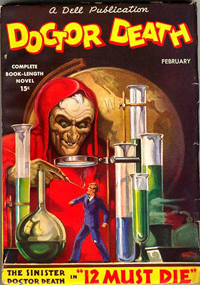Pulp magazines were inexpensive fiction magazines that were published from 1896 to the late 1950s. The term "pulp" derives from the cheap wood pulp paper on which the magazines were printed. In contrast, magazines printed on higher-quality paper were called "glossies" or "slicks". The typical pulp magazine had 128 pages; it was 7 inches (18 cm) wide by 10 inches (25 cm) high, and 0.5 inches (1.3 cm) thick, with ragged, untrimmed edges. Pulps were the successors to the penny dreadfuls, dime novels, and short-fiction magazines of the 19th century.

Weird Tales is an American fantasy and horror fiction pulp magazine founded by J. C. Henneberger and J. M. Lansinger in late 1922. The first issue, dated March 1923, appeared on newsstands February 18. The first editor, Edwin Baird, printed early work by H. P. Lovecraft, Seabury Quinn, and Clark Ashton Smith, all of whom went on to be popular writers, but within a year, the magazine was in financial trouble. Henneberger sold his interest in the publisher, Rural Publishing Corporation, to Lansinger, and refinanced Weird Tales, with Farnsworth Wright as the new editor. The first issue under Wright's control was dated November 1924. The magazine was more successful under Wright, and despite occasional financial setbacks, it prospered over the next 15 years. Under Wright's control, the magazine lived up to its subtitle, "The Unique Magazine", and published a wide range of unusual fiction.

Hugh Barnett Cave was an American writer of various genres, perhaps best remembered for his works of horror, weird menace and science fiction. Cave was one of the most prolific contributors to pulp magazines of the 1920s and '30s, selling an estimated 800 stories not only in the aforementioned genres but also in western, fantasy, adventure, crime, romance and non-fiction. He used a variety of pen names, notably Justin Case under which name he created the antihero The Eel. A war correspondent during World War II, Cave afterwards settled in Jamaica where he owned and managed a coffee plantation and continued his writing career, now specializing in novels as well as fiction and non-fiction sales to mainstream magazines.
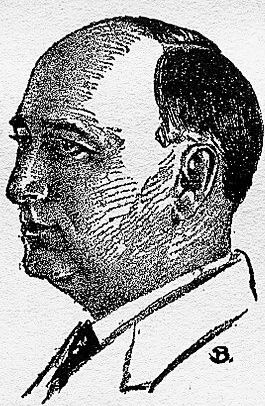
David Henry Keller was an American writer who worked for pulp magazines in the mid-twentieth century, in the science fiction, fantasy, and horror genres. He was also a psychiatrist and physician to shell-shocked soldiers during World War I and World War II, and his experience treating mentally ill people is evident in some of his writing, which contains references to mental disorders. He initially wrote short stories as a hobby and published his first science fiction story in Amazing Stories in 1928. He continued to work as a psychiatrist while publishing over sixty short stories in science fiction and horror genres. Technically, his stories were not well-written, but focused on the emotional aspects of imaginative situations, which was unusual for stories at the time.
Robert Edward Weinberg was an American author, editor, publisher, and collector of science fiction. His work spans several genres including non-fiction, science fiction, horror, and comic books.
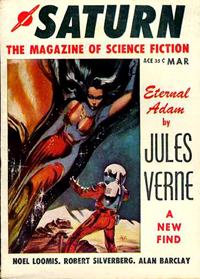
Saturn was an American magazine published from 1957 to 1965. It was launched as a science fiction magazine, but sales were weak, and after five issues the publisher, Robert C. Sproul, switched the magazine to hardboiled detective fiction that emphasized sex and sadism. Sproul retitled the magazine Saturn Web Detective Story Magazine to support the change, and shortened the title to Web Detective Stories the following year. In 1962, the title was changed yet again, this time to Web Terror Stories, and the contents became mostly weird menace tales—a genre in which apparently supernatural powers are revealed to have a logical explanation at the end of the story.
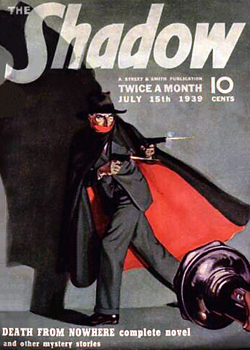
The Shadow was an American pulp magazine that was published by Street & Smith from 1931 to 1949. Each issue contained a novel about the Shadow, a mysterious crime-fighting figure who had been invented to narrate the introductions to radio broadcasts of stories from Street & Smith's Detective Story Magazine. A line from the introduction, "Who knows what evil lurks in the hearts of men? The Shadow knows", prompted listeners to ask at newsstands for the "Shadow magazine", which convinced the publisher that a magazine based around a single character could be successful. Walter Gibson persuaded the magazine's editor, Frank Blackwell, to let him write the first novel, The Living Shadow, which appeared in the first issue, dated April 1931.

Science Fiction Adventures was an American digest-size science fiction magazine, published from 1956 to 1958 by Irwin Stein's Royal Publications as a companion to Infinity Science Fiction, which had been launched in 1955. Larry Shaw was the editor for all 12 issues. Science Fiction Adventures focused on longer fiction than appeared in Infinity; these were often labeled as novels, though they were rarely longer than 20,000 words. Shaw declared in his first editorial that he wanted to bring back a "sense of wonder", and he printed straightforward action-adventure stories. Two other magazines of the period, Imagination and Imaginative Tales, had similar editorial approaches, but science fiction historian Mike Ashley considers that Science Fiction Adventures contained the best fiction of the three. Robert Silverberg was a prolific contributor, under his own name and under the pseudonym "Calvin M. Knox", and he also collaborated with Randall Garrett on two stories in the first issue, under two different pseudonyms. Other well-known writers occasionally appeared, including Harlan Ellison, Cyril M. Kornbluth, Algis Budrys, and Harry Harrison. Ed Emshwiller contributed cover art for nine of the twelve issues, and one of the other three was among John Schoenherr's earliest sales.

Doc Savage was an American pulp magazine that was published from 1933 to 1949 by Street & Smith. It was launched as a follow-up to the success of The Shadow, a magazine Street & Smith had started in 1931, based around a single character. Doc Savage's lead character, Clark Savage, was a scientist and adventurer, rather than purely a detective. Lester Dent was hired to write the lead novels, almost all of which were published under the house name "Kenneth Robeson". A few dozen novels were ghost-written by other writers, hired either by Dent or by Street & Smith. The magazine was successful, but was shut down in 1949 as part of Street & Smith's decision to abandon the pulp magazine field completely.

Ace Mystery was a weird menace pulp magazine which published three issues starting in 1936, followed by two more under the title Detective Romances.

New Mystery Adventures was a pulp magazine that appeared from 1935 to 1937. It included a mix of genres: there were occasional science fiction stories, and fantasies such as "Buried Alive" by Wayne Rogers and "Rescued by Satan" by Richard B. Sale, as well as adventure stories by authors such as L. Ron Hubbard. There were also mystery stories and weird menace stories. One story in Lars Anderson's "Domino Lady" series appeared, and other mystery writers included Octavus Roy Cohen and Steve Fisher.

The Spider was an American pulp magazine that was published by Popular Publications from 1933 to 1943. Every issue included a lead novel that featured The Spider, a heroic crimefighter. The magazine was intended as a rival to the Street & Smith's The Shadow and Standard Magazine's The Phantom Detective, which also featured crime-fighting heroes. The novels in the first two issues were written by R. T. M. Scott; thereafter every lead novel was credited to "Grant Stockbridge", a house name. Norvell Page, a prolific pulp author, wrote most of these; almost all the rest were written by Emile Tepperman and A. H. Bittner. The novel in the final issue was written by Prentice Winchell.
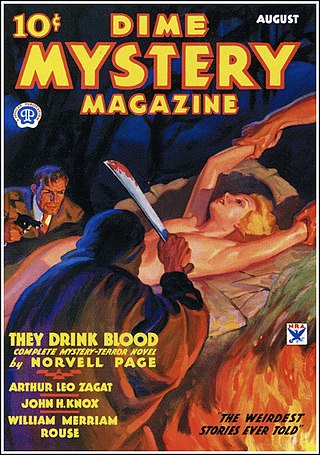
Dime Mystery Magazine was an American pulp magazine published from 1932 to 1950 by Popular Publications. Titled Dime Mystery Book Magazine during its first nine months, it contained ordinary mystery stories, including a full-length novel in each issue, but it was competing with Detective Novels Magazine and Detective Classics, two established magazines from a rival publisher, and failed to sell well. With the October 1933 issue the editorial policy changed, and it began publishing horror stories. Under the new policy, each story's protagonist had to struggle against something that appeared to be supernatural, but would eventually be revealed to have an everyday explanation. The new genre became known as "weird menace" fiction; the publisher, Harry Steeger, was inspired to create the new policy by the gory dramatizations he had seen at the Grand Guignol theater in Paris. Stories based on supernatural events were rare in Dime Mystery, but did occasionally appear.
The Western Raider was an American pulp magazine. The first issue was dated August/September 1938; it was followed by two more issues under that title, publishing Western fiction, and then was changed to a crime fiction pulp for two issues, titled The Octopus and The Scorpion. Both these two issues were named after a supervillain, rather than after a hero who fights crime, as was the case with most such magazines. Norvell Page wrote the lead novels for both the crime fiction issues; the second was rewritten by Ejler Jakobsson, one of the editors, to change the character from The Octopus to The Scorpion.

The Mysterious Wu Fang was a pulp magazine which published seven issues in 1935 and 1936. Sax Rohmer's Fu Manchu, an oriental villain, was a "yellow peril" stereotype, and Popular Publications wanted to take advantage of the public's interest. The author of all seven lead novels was Robert J. Hogan, who was simultaneously writing the novels for G-8 and His Battle Aces, producing 130,000 to 150,000 words per month; Hogan was told to not to rewrite, but to deliver his first drafts. The hero of the novels was a man named Val Kildare; other characters included a young assistant to Kildare, who was probably added to attract younger readers. The artist John Richard Flanagan, who had experience illustrating Fu Manchu, was hired, but in the opinion of pulp historian Robert Weinberg, "an imitation was an imitation, and the magazine did not sell well". There were short stories along with the lead novel in each issue, also with a "yellow peril" theme; the authors included Steve Fisher, Frank Gruber, O.B. Meyers, and Frank Beaston. The magazine was cancelled after seven issues in favor of a similar magazine with a different villain: Dr. Yen Sin. According to pulp historian Joseph Lewandowski, the decision to switch titles may have been because Wu Fang was too juvenile, and Dr. Yen Sin was supposed to be more mature.

Operator #5 was a pulp magazine published between 1934 and 1939.
Thrilling Mystery was an American pulp magazine published from 1935 to 1944. New York publisher Standard Magazines had a stable of magazines with the "Thrilling" prefix, including Thrilling Detective, Thrilling Love, and Thrilling Adventures, but in 1935, Popular Publications, a rival publisher, launched a weird menace pulp titled Thrilling Mysteries. Standard Magazines sued over the use of the word "Thrilling", and Popular conceded, settling out of court. Thrilling Mysteries was cancelled after a single issue, and in October 1935 Standard began Thrilling Mystery. Like Thrilling Mysteries this was a terror pulp, but it contained less sex and violence than most of the genre, and as a result, in the opinion of science fiction historian Mike Ashley, "the stories had greater originality, although they are not necessarily of better quality". Ashley singles out Carl Jacobi's "Satan's Kite", about a family cursed because of a theft from a temple in Borneo, as worthy of mention. There were two detective stories by Robert E. Howard, the creator of Conan. Other contributors included Fritz Leiber, Fredric Brown, Seabury Quinn, Robert Bloch, and Henry Kuttner. There was little science fiction in the magazine, but some fantasy: pulp historian Robert K. Jones cites Arthur J. Burks "Devils in the Dust" as "one of the most effective" stories, with "a mood as bleak as an arctic blizzard", and Ashley agrees, calling it "particularly powerful".

Eerie Stories was an American weird menace pulp magazine that published one issue in 1937. The publisher had failed with another weird menace pulp, Ace Mystery, the year before, and pulp historian Robert K. Jones comments that Eerie Stories was "even feebler". All twelve stories were written under house names; one, "Mate of the Beast" by Leon Dupont, was a reprint from Ace Mystery with a new title, and there may have been other reprints. In the opinion of pulp historian Michael L. Cook, the stories "really had no redeeming value and were even poor entertainment". The tagline was "Startling Adventures in Chilling Horror", but in Jones' opinion the stories fell short.

Captain Zero was an American pulp magazine that published three issues in 1949 and 1950. The lead novels, written by G.T. Fleming-Roberts, featured Lee Allyn, who had been the subject of an experiment with radiation, and as a result was invisible between midnight and dawn. Under the name Captain Zero, Allyn became a vigilante, fighting crime at night. Allyn had no other superpowers, and the novels were straightforward mysteries in Weinberg's opinion, though pulp historian Robert Sampson considers them to be "complex...[they] pound along with hair-raising incidents..full of twists and high suspense". Captain Zero was the last crime-fighter hero magazine to be launched in the pulp era, ending an era that had begun with The Shadow in 1931. There was room in the magazine for only one or two short stories along with the lead novel; these were all straight mystery stories, without the veneer of science fiction of the Captain Zero novels.

Battle Birds was an American air-war pulp magazine, published by Popular Publications. It was launched at the end of 1932, but did not sell well, and in 1934 the publisher turned it into an air-war hero pulp titled Dusty Ayres and His Battle Birds. Robert Sidney Bowen, an established pulp writer, provided the lead novel each month, and also wrote the short stories that filled out the issue. Bowen's stories were set in the future, with the United States menaced by an Asian empire called the Black Invaders. The change was not successful enough to be extended beyond the initial plan of a year, and Bowen wrote a novel in which, unusually for pulp fiction, Dusty Ayres finally defeated the invaders, to end the series. The magazine ceased publication with the July/August 1935 issue. It restarted in 1940, under the original title, Battle Birds, and lasted for another four years. All the cover art was painted by Frederick Blakeslee.
